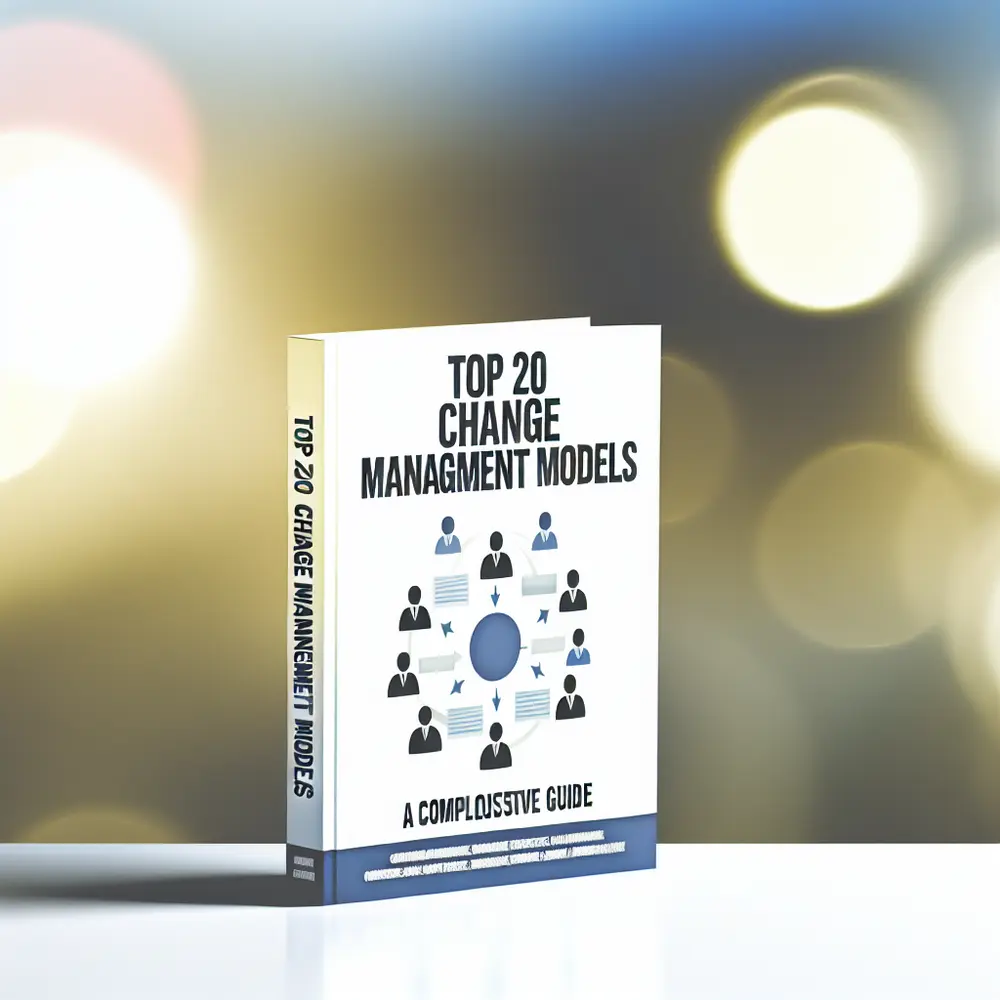In today’s fast-paced business landscape, change is constant. Organizations often struggle with the complexities of transformation, facing resistance, misalignment, and employee disengagement. Business leaders, HR professionals, and project managers need robust strategies to navigate these challenges effectively. Change management models provide structured frameworks that enhance the organizational capacity to implement change and achieve desired outcomes.
Understanding the nuances of these models is critical. Each model offers unique insights and methodologies that can address specific challenges during transitions. Adopting a tailored approach based on the organization’s culture and needs not only fosters buy-in from stakeholders but also paves the way for smoother transformations. By leveraging the strengths of various change management models, organizations can enhance adaptability and resilience.
As we delve into the world of change management models, we will explore their key components, theories, and practical applications. You’ll learn how to implement these frameworks effectively, paving the way toward successful business transformations and creating a culture that embraces change.
Introduction to Change Management Models
Change management models are essential frameworks that guide your organization through periods of transition. They help manage transformations effectively, encompassing a range of theories and strategies that facilitate organizational change. By understanding these models, you ensure deeper insights for business leaders, HR professionals, and project managers aiming for successful business transformations.
A key advantage of these models is their structured approaches to address the complexities of organizational change. They assist in analyzing the need for change, planning necessary steps, and executing strategies to minimize resistance and maximize employee acceptance. By leveraging these models, you significantly improve the chances of achieving desired outcomes during transitions.
Moreover, these models are underpinned by various management theories. They provide insights into human behavior, team dynamics, and leadership practices during times of change. For instance, Kotter’s 8-Step Process and Lewin’s Change Management Model emphasize communication and stakeholder engagement, fostering a supportive environment for change.
Implementing change management models successfully requires a clear understanding of each organization’s unique challenges. Factors like culture, employee resistance, and the nature of change can influence effectiveness. Therefore, adapting these frameworks to your context is essential to ensure they resonate with your workforce and align with overall objectives.
In summary, mastering change management models is vital for guiding your organization through business transformation. Utilizing these structured frameworks allows you to effectively manage organizational change and enhance employee buy-in, achieving successful outcomes. As the business landscape evolves, mastering these models becomes indispensable for your competitiveness.
Understanding the Need for Change Management in Organizations
Change management models are crucial for guiding your organization through transformation complexities. Understanding these frameworks empowers you to navigate change effectively, ensuring smooth transitions while enhancing resilience. Organizations today face constant pressures for transformation, driven by technology, competition, and changing consumer expectations.
Implementing these models becomes vital as they help anticipate challenges, minimizing resistance while fostering acceptance among all stakeholders. A defined change management process serves as a roadmap for guiding employees through transitions, crucial in environments demanding innovation for survival. Focusing on communication, training, and support systems fosters effective engagement.
Furthermore, integrating management theory principles helps apply these models practically. Frameworks like Kotter’s Eight Steps or Lewin’s Model highlight the necessary steps for successful transformation, equipping leaders with strategies to actively involve their teams and ensure alignment with corporate vision.
Change management models serve as practical tools that drive real business results. Organizations increasingly rely on digitalization and automation tools like CRM for WhatsApp, emphasizing the need for effective change management. Thoughtfully implementing these models ensures technology integrations enhance productivity.
In conclusion, understanding the need for change management equips today’s leaders. These models provide structured techniques to navigate organizational change, aligning businesses with the demands of an evolving market. Effective utilization drives successful transformations and cultivates resilient cultures.
Key Theories Behind Change Management
Change management models utilize essential frameworks that guide your organization through transformation processes. These models facilitate structured approaches to implementing change, ensuring you meet individual and organizational objectives efficiently. As transformations grow in importance, understanding key theories is crucial for successful change management.
Kurt Lewin’s Change Management Model sets a foundational theory encompassing three stages: Unfreeze, Change, and Refreeze. This model emphasizes preparing individuals for change by addressing concerns and creating compelling reasons to change. A stable environment streamlines transitions, mitigating resistance while fostering employee acceptance.
John Kotter’s Eight-Step Process provides a step-by-step guide for leading successful change initiatives. Emphasizing urgency, coalition formation, and developing a vision, this comprehensive method allows you to manage organizational change effectively, ensuring sustainable outcomes.
David Gleicher’s Formula for Change expands on Kotter’s theory. It emphasizes the interaction of three variables: dissatisfaction with the status quo, a clear vision of the future, and practical steps to achieve that vision. This model underscores the need to motivate change at both individual and collective levels.
The McKinsey 7-S Framework examines seven critical elements: Strategy, Structure, Systems, Shared Values, Skills, Style, and Staff. This holistic approach guarantees all aspects of your organization align during a change process, highlighting both hard and soft elements that significantly influence transformation success.
Key Theories Comparison: Kotter vs. Lewin
When comparing Kotter’s and Lewin’s models, both offer structured methodologies for managing change. Kotter focuses on a detailed step-by-step process that motivates individuals through urgency and coalition building, while Lewin provides a simpler framework with its three stages, emphasizing the need to manage resistance effectively.
Top 20 Change Management Models Explained
Understanding change management models prepares your organization for effective transitions. These structured approaches ensure smooth, predictable, and successful management of change initiatives. Here’s an overview of prominent models you should consider:
One widely recognized framework is Kotter’s 8-Step Process. It emphasizes urgency, coalition formation, and developing a vision for effective employee commitment. Particularly useful in large-scale transformations, it facilitates buy-in and minimizes resistance.
The ADKAR model focuses on individual journeys through change; its components—Awareness, Desire, Knowledge, Ability, and Reinforcement—are critical in HR training and development to support effective change.
Lewin’s Change Management Model aids in understanding the necessary phases for sustainable implementation, while the McKinsey 7-S Framework collaborates seven interdependent elements. By analyzing these components, your organization can diagnose and optimize strategies.
Bridges’ Transition Model addresses the psychological transitions associated with change, highlighting the importance of communication to support employees effectively through the emotional journey of transformations.
These models equip you with tools necessary for navigating organizational change and driving sustainable growth. For example, integrating a chatbot for e-commerce can streamline interactions and support various change management initiatives.
Kotter’s 8-Step Change Model
Kotter’s 8-Step Change Model serves as an invaluable roadmap for successfully managing organizational change. This foundational framework guides you through transformational initiatives, offering clear steps for effective transitions.
Creating urgency highlights the necessity for change within your organization, motivating stakeholders by identifying potential threats and opportunities. Forming a powerful coalition of influential individuals subsequently supports this transformation.
Developing a clear vision for change and effective communication ensures all employees understand and accept the strategy, minimizing potential resistance during transitions. Empowering employees to act on the vision strengthens innovation and removes obstacles, leading to quick wins that boost morale.
Next, consolidating gains and producing further change allows you to leverage early successes. Anchoring new approaches in the organizational culture is essential for ensuring lasting impacts and sustainable growth.
In summary, adhering to Kotter’s 8-Step Change Model enhances your ability to navigate the complexities of organizational change. Integrating this framework with tools like CRM for WhatsApp further streamlines communication and supports transformation processes.
Lewin’s Change Management Model
Lewin’s Change Management Model outlines a straightforward three-stage process: Unfreezing, Change, and Refreezing, recognized for its effectiveness in managing organizational change. A clear understanding of these stages helps you navigate complexities associated with transitions.
The “Unfreezing” stage prepares your organization to accept change. Effective communication plays a key role here, as it fosters understanding and reduces anxieties. Once the organization is prepared, the “Change” phase involves implementing new practices, processes, or systems.
In “Refreezing,” stabilizing the organization after change solidifies the new state of operations. Reinforcing new behaviors through updated policies and ongoing training ensures that change becomes embedded in the organizational culture, minimizing chances of reverting to old habits.
Overall, Lewin’s Change Management Model is a versatile framework for addressing organizational change. By following the structured approach of unfreezing, changing, and refreezing, your organization can thrive amidst business transformations.
ADKAR Model
The ADKAR model is a powerful framework designed to facilitate organizational change, emphasizing individual experiences throughout transformations. The acronym stands for Awareness, Desire, Knowledge, Ability, and Reinforcement, each component playing a vital role in managing change effectively.
Building Awareness informs employees about the necessity for change. This foundational step paves the way for smooth implementation. The Desire phase focuses on motivating team members to support the initiative; encouraging open dialogue and addressing concerns fosters participation.
Providing employees with Knowledge through training and resources equips them for new environments. The Ability stage ensures individuals can effectively apply this knowledge, supported by ongoing assistance. Finally, Reinforcement solidifies new behaviors to maintain the change over time.
The ADKAR model stands out for prioritizing individual experiences, making it an essential tool for navigating organizational changes smoothly and driving effective transformations.
McKinsey 7-S Framework
The McKinsey 7-S Framework emphasizes a holistic approach in change management by addressing seven interconnected elements: Strategy, Structure, Systems, Shared Values, Style, Staff, and Skills. Acknowledging these relationships promotes effective change management for your organization.
Aligning your strategy with the organizational objectives sets the foundation for change. The structure, outlining the hierarchy and communication paths, reinforces clarity, which is essential during critical transformation phases. The alignment of systems with new strategies facilitates smoother operations.
Shared Values reflect your organization’s culture, shaping employee behaviors and influencing commitment. The remaining elements—Style, Staff, and Skills—are integral in managing people through the transition. Investing in training fosters competencies aligned with evolving business requirements.
Utilizing the McKinsey 7-S Framework enables comprehensive change management strategies, enhancing responsiveness to market dynamics and cultivating a culture of continuous improvement.
Bridges’ Transition Model
Bridges’ Transition Model highlights the psychological transitions individuals experience during periods of organizational change, differentiating between situational change and psychological transition. This model outlines three phases: Ending, Neutral Zone, and New Beginning.
In the Ending phase, helping individuals let go of old practices is crucial to mitigate resistance and support effective transitions. During the Neutral Zone, leaders must provide support and foster open dialogue, guiding employees through confusion. This period serves as an opportunity for training and development.
Ultimately, the New Beginning phase marks when individuals are ready to adopt new practices. Celebrating achievements during this phase reinforces the vision that inspired change, bolstering morale and engagement.
Applying Bridges’ Transition Model facilitates smoother transitions and promotes success by recognizing the emotional aspects of change and engaging employees throughout the process.
Nudge Theory
Nudge Theory focuses on subtly guiding individuals toward desired behaviors without restricting their freedom of choice, making it a valuable tool in change management. To implement this theory effectively, you must understand behavioral economics and leverage psychological insights.
In practice, nudging can take various forms, from altering default settings to incentivizing desired actions. For instance, redesigning workspaces to encourage collaboration can enhance the environment and facilitate change.
Nudge Theory aligns well with traditional management theories, emphasizing the importance of employee engagement during change. Supporting employees and valuing their opinions promotes the adoption of changes, reducing resistance.
Ultimately, integrating Nudge Theory equips your organization with innovative techniques for guiding behavior, improving outcomes, and navigating change complexities while maintaining morale.
Kübler-Ross Change Curve
The Kübler-Ross Change Curve provides insights into how individuals process organizational change, outlining five emotional stages: denial, anger, bargaining, depression, and acceptance. Understanding these stages enables business leaders to support their teams effectively.
Employees often resist change during denial, which can hinder progress. Addressing these feelings constructively can minimize disruption. In the anger stage, feelings of frustration may escalate; helping employees voice their concerns and emphasizing the change’s necessity promotes engagement.
As individuals transition to bargaining, they may seek negotiation or revert to previous practices. Encouraging open communication during this phase reinforces the benefits of the new path and fosters acceptance.
Finally, the acceptance stage marks when employees embrace new realities. Celebrating milestones solidifies positive behaviors and encourages a culture that embraces change. The Kübler-Ross Change Curve serves as a valuable tool for facilitating effective transitions.
The Satir Change Model
The Satir Change Model offers vital insights into human dynamics during organizational change, emphasizing the emotional and practical aspects of business transformation. Its five stages—Late Status Quo, Resistance, Chaos, Integration, and New Status Quo—illustrate how organizations navigate change.
Initially, organizations experience a Late Status Quo, where stability exists. As changes are introduced, you often encounter Resistance from employees fearful of the unknown. Managing this response is essential for smoother transitions.
Moving into Chaos brings confusion and unrest; leaders must maintain engagement through open communication and support. Successfully guiding teams out of Chaos leads to Integration, where employees adapt to new processes and start creating a shared understanding.
The final New Status Quo signifies the realization of organizational change. Reflecting on this journey helps assess the effectiveness of your change management strategy, ensuring lasting impacts.
The Change Path Model
The Change Path Model offers a structured approach to implementing organizational change through three distinct phases: Awareness, Desire, and Knowledge. By understanding these phases, you can facilitate smoother transitions during periods of change.
In the Awareness phase, clearly communicating the need for change is crucial. Engage in open dialogues and utilize communication channels to ensure employees understand motivations behind their changes.
Fostering Desire involves creating a willingness among employees to support change initiatives. Recognizing emotions and addressing resistance through incentives and support cultivates a positive attitude toward change.
The Knowledge phase equips employees with skills and information required to succeed in the new environment. Training programs enhance competencies, while management theories provide a foundation for learning, aiding effective transitions.
Additionally, ongoing feedback and evaluation are crucial following change implementation. Regular assessments allow leaders to identify areas for improvement and maintain the momentum of transformation. The Change Path Model offers valuable structuring for successful change management strategies.
The 4 P’s of Change Management
The 4 P’s of change management—Project, Purpose, People, and Process—set a foundation for effective business transformation. Understanding and applying these elements significantly increases the likelihood of successful change initiatives.
Project
The first element, Project, refers to the specific change initiative within your organization. Leaders must articulate the scope and objectives, ensuring commitment from stakeholders across all levels.
Purpose
The Purpose encompasses the rationale behind the change. Communicating why it is necessary engages employees and creates a shared vision. A compelling purpose motivates teams to embrace change.
People
This aspect highlights the human element of change management, recognizing individual and team impacts. Engaging employees throughout the process fosters buy-in and lowers resistance.
Process
Lastly, the Process outlines steps taken to implement change effectively. Employing structured methodologies and monitoring progress can significantly enhance transformation efforts, ensuring adjustments are made swiftly as necessary.
Utilizing the 4 P’s enables you to navigate the complexities of organizational change effectively, fostering a resilient business culture.
Appreciative Inquiry
Appreciative Inquiry emphasizes positive organizational aspects rather than focusing on issues, fostering a culture of collaboration and shared vision. Its 5D cycle—Define, Discover, Dream, Design, and Destiny—serves as a powerful change management model.
The Define phase identifies what is to be studied, while the Discover phase gathers success stories and examples, cultivating appreciation among stakeholders. In the Dream phase, a collective vision for an ideal future emerges.
The Design phase crafts frameworks and practices needed to achieve the envisioned future. Finally, the Destiny phase integrates new processes into daily operations, fostering continuous improvement.
Appreciative Inquiry stands apart from traditional management theories by inspiring engagement and participation. Organizations utilizing this model experience enhanced collaboration, resilience against challenges, and improved problem-solving abilities.
Action Research Model
The Action Research Model emphasizes continuous learning and participation, allowing organizations to adapt effectively. Key to this model is the action-reflection cycle, beginning with diagnosing the current situation collaboratively.
Once issues are identified, action planning involves devising strategies for resolution. By aligning action plans with organizational goals, you empower team members and ensure meaningful changes.
Executing change initiatives involves continuous monitoring and collecting feedback for adjustments. Reflection post-implementation evaluates the effectiveness and informs future actions, fostering a culture of improvement.
In conclusion, the Action Research Model empowers you to navigate organizational change successfully. Its emphasis on collaboration and adaptability positions organizations to respond effectively to market challenges.
Organizational Change Agile Model
The Organizational Change Agile Model integrates Agile principles into change management, focusing on flexibility, collaboration, and iterative progress. Emphasizing empowerment through cross-functional teams, this model fosters innovation in change processes.
Breaking change initiatives into manageable phases allows for ongoing evaluation, ensuring alignment with business goals. Integrating Agile methods enhances responsiveness to challenges while promoting a culture of continuous improvement.
Aligning Agile practices with existing change management frameworks can amplify effectiveness. By employing a hybrid approach, organizations benefit from both traditional and modern methodologies, ensuring effective navigation through complex transformations.
Ultimately, the Organizational Change Agile Model offers a robust framework for driving successful change initiatives, fostering engagement, and maintaining alignment throughout the transition process.
The PDCA Cycle
The PDCA Cycle—Plan, Do, Check, and Act—is a tightly structured model of change management, promoting continuous improvement within organizations. The Plan phase identifies goals and formulates action strategies, laying a foundation for successful change.
The Do phase involves implementing these plans while ensuring effective communication and collaboration. Regular updates foster engagement and minimize resistance, while the Check phase assesses outcomes against expectations.
In the Act phase, organizations adapt strategies based on evaluations, ensuring continued relevance to evolving environments. This iterative process drives sustained change and fosters accountability.
Overall, the PDCA Cycle serves as a powerful change management model, empowering organizations to achieve continuous transformation and fostering a resilient culture.
The Prosci Change Triangle
The Prosci Change Triangle highlights the critical connections between Awareness, Desire, Knowledge, Ability, and Reinforcement. By understanding these elements, organizations can create targeted strategies for successful change initiatives.
Awareness establishes the need for change, laying the groundwork for buy-in. Desire motivates individuals to support transformation, fostering emotional engagement and collaboration.
Knowledge equips employees with the necessary skills, while Ability ensures individuals can effectively implement these changes. Reinforcement is crucial to sustain new practices and behaviors, ensuring they remain embedded over time.
By leveraging the Prosci Change Triangle, organizations can navigate the complexities of change, empowering leaders, HR professionals, and project managers to drive effective business transformations.
The Lean Change Model
The Lean Change Model combines Lean and Agile methodologies, creating an adaptable framework for change management. Engaging employees as active participants in the change process fosters collaboration and innovation.
Clearly communicating the essence of change, testing new ideas on a small scale, and gathering continuous feedback encourage a culture of experimentation. This approach allows organizations to validate assumptions and adjust strategies based on real-time insights.
Prioritizing stakeholder input strengthens relationships and ensures effective transitions. The Lean Change Model champions collaboration, responsiveness, and a commitment to continuous improvement during organizational transformations.
The Systems Theory of Change
The Systems Theory of Change emphasizes interconnectedness within organizations, recognizing that changes in one area can impact others. By fostering holistic approaches, leaders manage transformations more effectively.
Continuous feedback and adaptation allow organizations to respond agilely to evolving challenges. Prioritizing relationships and communication cultivates a culture of inclusivity, enhancing buy-in and support for change initiatives.
Integrating technology can amplify the effectiveness of Systems Theory, using tools like automatic Whatsapp customer service tools to foster real-time data collection and analysis. The Systems Theory offers a strategic framework that drives long-term organizational change through relationships.
The Change Kaleidoscope
The Change Kaleidoscope encapsulates the multifaceted nature of change management, illustrating that change processes require multiple factors for effective navigation. Contextual awareness and adaptability are paramount in this model.
Effective communication ensures stakeholders understand the rationale for change, promoting collaboration and reducing resistance. Examining the organizational culture, stakeholder engagement, and external factors leads to tailored change management strategies.
Ultimately, the Change Kaleidoscope emphasizes the importance of adaptability and contextual evaluation, allowing business leaders and HR professionals to enhance their change management strategies and achieve successful outcomes.
The C-Suite Change Model
The C-Suite Change Model reinforces the vital role of leaders during transformations. By articulating a clear vision and fostering buy-in, executives contribute to effective organizational change.
Visibility and accessibility are essential. C-suite leaders engaging employees during transitions builds trust, addressing concerns and highlighting transformation benefits. Establishing feedback mechanisms cultivates inclusivity.
Robust evaluation processes allow leaders to assess change initiatives’ effectiveness while monitoring key performance indicators. By leveraging the elements of the C-Suite Change Model, organizations navigate complexities more effectively, embracing change as a pathway to growth and innovation.
The ADAPT Model
The ADAPT model, acronym for Assess, Design, Activate, Perfect, and Transfer, offers a structured approach to organizational change. Its comprehensive framework ensures alignment with change objectives.
In the Assess phase, evaluating the current state identifies challenges and opportunities, while the Design phase focuses on creating a strategic change plan. Engaging stakeholders during this phase fosters commitment.
Activating change involves deploying resources and communication strategies, ensuring clarity and motivation through the transition process. The Perfect phase monitors progress and facilitates adjustments, reinforcing a culture of continuous improvement.
Finally, Transfer solidifies changes, embedding new practices into daily operations. Cultivating a growth mindset ensures long-term effectiveness. The ADAPT model serves as a guide for managing transitions successfully, preparing organizations for future challenges.
Evaluating the Effectiveness of Change Management Models
Assessing change management models is vital for ensuring successful transformations. Effective models provide clarity and structure, guiding organizations through complexities associated with change. Consider dimensions such as employee engagement support, adaptability to organizational culture, and the feasibility of metrics in evaluating these models.
Models prioritizing communication often yield better outcomes. Those failing to engage employees risk stagnation and resistance. Evaluating models against organizational cultures and customizing elements when necessary enables effective implementations.
Measuring success via KPIs related to morale, productivity, and retention offers insights into change initiatives. Incorporating feedback mechanisms ensures continuous improvement adapting to unforeseen challenges.
Complementary tools, like CRM for WhatsApp, enhance communication and streamline interactions during change processes. Evaluating change management models provides leaders with knowledge for informed decisions, leading to resilient organizations.
Common Challenges in Implementing Change Management Models
Implementing change management models presents challenges that can hinder transformation. Addressing resistance from employees is a significant issue; leaders must ensure transparent communication regarding change rationale and benefits.
Inadequate training and support can lead to struggles with new systems. Investing in comprehensive training programs equips employees with skills necessary to adapt efficiently.
Aligning initiatives with organizational goals is crucial. Without alignment, confusion may arise, wasting resources. Frequent communication reinforces understanding on how changes connect to broader objectives.
Measuring effectiveness can be difficult. Establishing clear success metrics aligned with desired outcomes allows monitoring of progress. Continuous assessments breed accountability and learning.
Lastly, sustaining momentum amidst change is vital. Fostering a culture of adaptability prepares teams for ongoing shifts in market dynamics. Addressing resistance, promoting training, and maintaining alignment can improve the outcomes of implementing change management models.
Best Practices for Successful Change Implementation
Successful change implementation relies on several best practices. Engaging stakeholders enhances the likelihood of success by fostering inclusive environments and gathering diverse insights.
Adopting a structured approach begins with clear goals and measurable objectives, ensuring alignment with the broader vision of transformation.
Training and support are central to enabling employees to adapt, enhancing confidence and competence throughout the transition.
Ongoing evaluation and adjustments based on feedback allow prompt responses to issues, promoting a culture of agility.
In conclusion, adhering to these practices—engagement, structure, robust training, and continuous evaluation—empowers organizations to effectively navigate complexities, cultivating a resilient workforce prepared for future changes.
Case Studies: Successful Applications of Change Management Models
Successful applications of change management models significantly enhance organizational transformations. Examining real-world examples illustrates the practical benefits of various models in implementation.
Procter & Gamble (P&G) effectively utilized Kotter’s 8-Step Change Model for a significant marketing department restructuring. This systematic approach created urgency and communication clarity, leading to streamlined operations and improved performance.
The Gates Foundation adopted Lewin’s Change Management Model, focusing on unfreezing current processes. By involving staff in the unfreezing phase, they fostered collaboration and buy-in, showcasing how foundational theories can guide success.
Microsoft leveraged the ADKAR model to transform corporate culture, enhancing engagement strategies. The company’s focus on systematic approaches and human factors drove innovation, reinforcing the significance of a well-rounded strategy.
General Electric (GE) implemented the McKinsey 7-S Framework during restructuring, aligning critical organizational elements with desired changes. This alignment resulted in improved productivity and satisfaction, proving the importance of holistic methods.
A smaller healthcare provider utilized the Bridges Transition Model during a merger, addressing emotional aspects of change. By prioritizing staff concerns, they eased anxieties, demonstrating that larger models can adapt to smaller organizations.
These case studies exhibit how change management models can drive organizational change successfully. Understanding these applications allows business leaders and HR professionals to better navigate their transformation journeys.
Conclusion: Choosing the Right Change Management Model for Your Organization
Selecting the right change management model is crucial for guiding your organization through transformation. Each model offers unique methodologies that impact organizational change effectiveness.
Consider specific needs when evaluating change management models. Incorporating strategies that resonate with your organization’s culture and objectives increases the likelihood of success. Adopting hybrid approaches by integrating elements from multiple models may additionally enhance effectiveness.
Engaging with stakeholders during the change process is critical. Models promoting feedback and communication yield better results by helping secure a shared purpose within the organization.
Lastly, consider measuring progress. Effective change management models include mechanisms for tracking success, ensuring adaptability to changing dynamics.
Ultimately, the right change management model aligns with your strategic objectives and organizational complexities. By thoughtfully assessing and implementing an appropriate model, you pave the way for successful transformation journeys.
For further insights on enhancing customer interactions and change management strategies, consider exploring the CRM for WhatsApp: Win More Customers and Scale Your Business.









